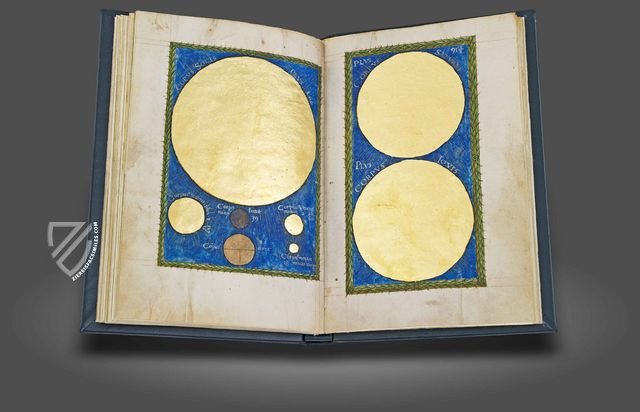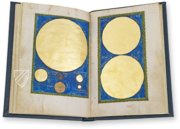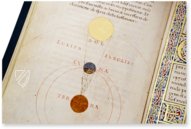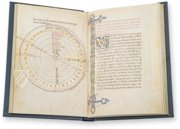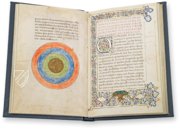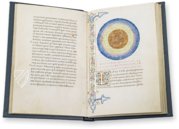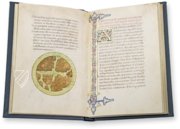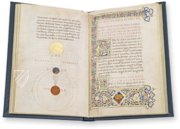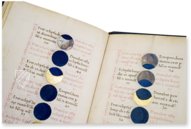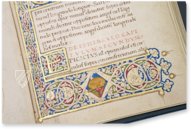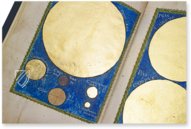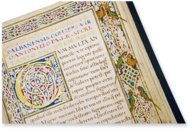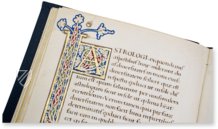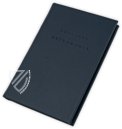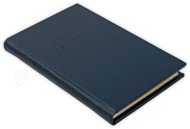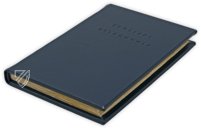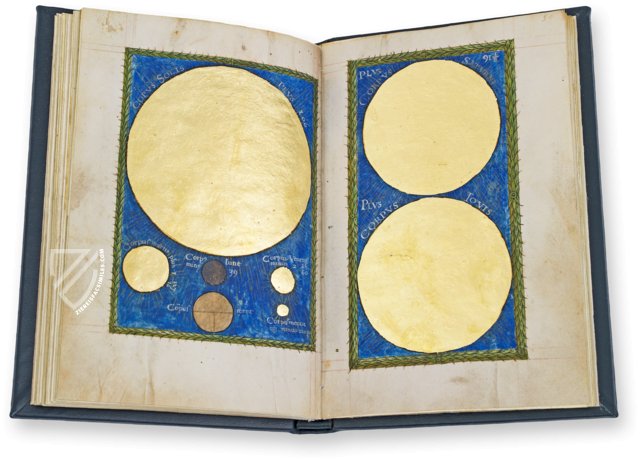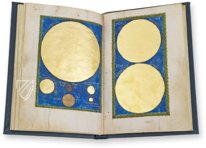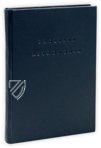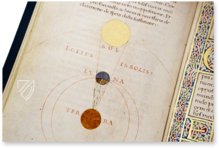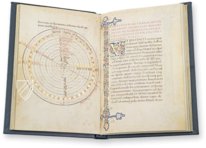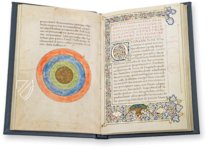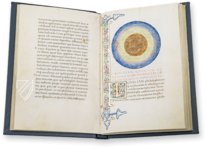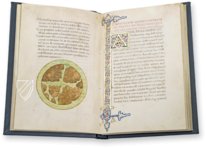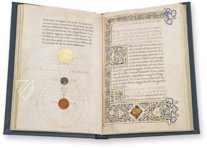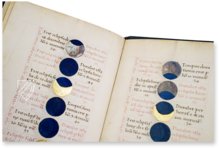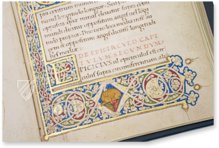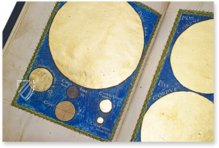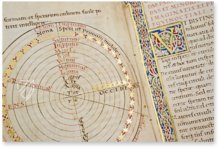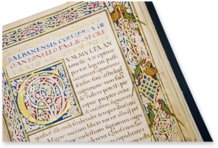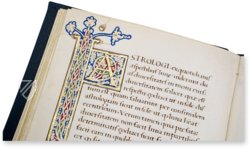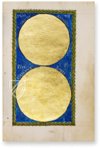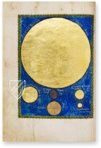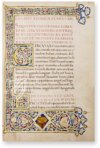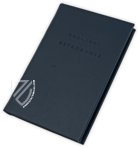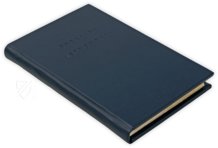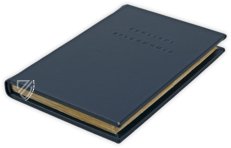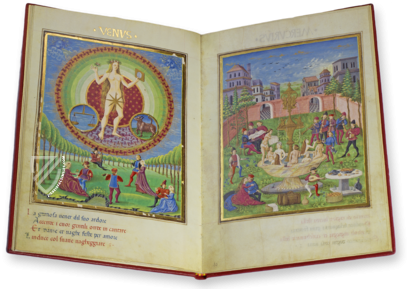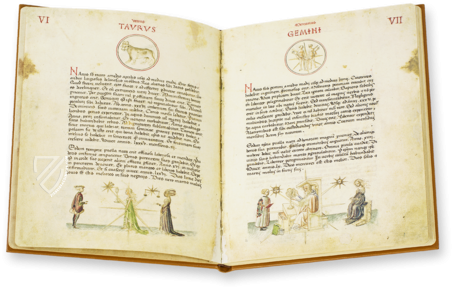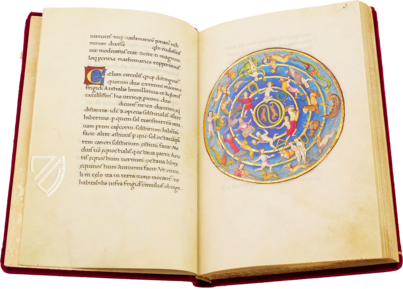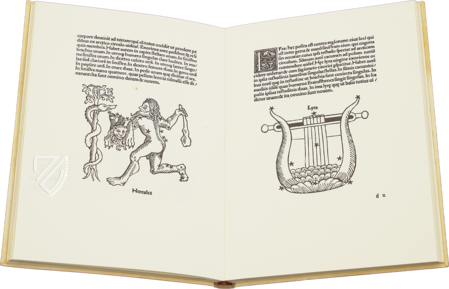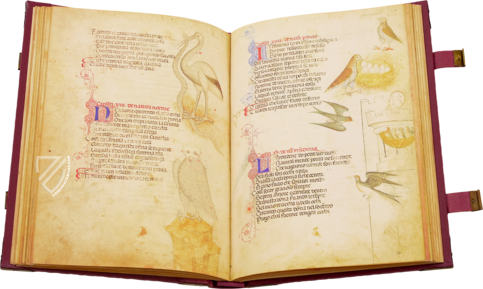Christianus Prolianus Astronomia
(1,000€ - 3,000€)
This astrological treatise completed in Naples in 1478 is one of the finest illuminated manuscripts of its kind and is adorned with shimmering golden planets and other heavenly bodies. Many of the text pages are adorned with bianchi girari frames – featuring splendid white branch-work on red-blue-green grounds that were typical of 15th century Italian Humanist manuscripts. Although it remains debated who the original owner was, it is likely that the person was associated with the royal family in Naples, which was then part of the Crown of Aragon. The treatise appears to be instructive in nature and is believed to have been written by a court astronomer, Cristiano Proliano, who was also employed as a tutor at court. It is believed to have been illuminated at the workshop of Gioacchino di Gigantibus de Rottenburg (fl. ca. 1453–1485), a German illuminator in Naples.
Christianus Prolianus Astronomia
A splendid astronomical manuscript with shimmering golden planets and gorgeous decorative frames full of symbolism: the Astronomia by Christianus Prolianus is a fine specimen of the Neapolitan Quattrocento. Although the identity of its original patron and owner has been debated, they were a member of the Aragonese royal family in Naples. Various diagrams attempt to explain the movements of the planets and celestial phenomena like eclipses, and the instructive text is presented in gorgeous bianchi girari frames –featuring splendid white branch-work on red-blue-green grounds that were typical of 15th century Italian Humanist manuscripts. Despite its debated provenance, it is one of the finest astronomy manuscripts ever created.
Golden Heavenly Spheres
The most eye-catching feature of the manuscript are its glimmering golden circles, which represent the Sun and planets of the solar system with the significant exceptions of Earth and the Moon, which are represented by a T and O map and a (now tarnished) silver circle, respectively. They likely originated along with the rest of the manuscript at the workshop of Gioacchino di Gigantibus de Rottenburg (fl. ca. 1453–1485), a German illuminator in Naples. As for the text itself, it was likely composed by a tutor for the children for the court secretary Petrucci named Cristiano Proliano, about whom little is known aside that he was born in Balvano in Basilicata. It was likely a teaching aid and consists of thirteen chapters divided into five parts beginning with Aristotle’s concept of the four elements that make up the celestial sphere before moving on to the solar system, astronomical geography, and even an attempt to explain eclipses in a geocentric model. Finally, there are tables covering the movements of celestial bodies and notes on eclipses beginning in 1478, all specifically referring to the “Meridian of Naples”.
A Glimpse of Contemporary Italian Politics
After being ruled by various French dynasties since the late–13th century, the Kingdom of Naples was conquered in 1442 by King Alfonso V of Aragon (1396–1458), who established a new dynasty as Alfonso I of Naples. Aside from being a warrior, Alfonso was also a patron of the arts and established a humanist court there with a particular focus on classical literature. With papal consent, he was able to name his illegitimate son Ferdinand his heir in Naples, while his brother John succeeded him in Spain as John II of Aragon. It would appear as though the crowned coat of arms found on the first page belongs to Ferdinand I of Naples (1423–94), but upon closer examination it is actually a mirror image of it. The prevalence of parakeets, which are associated with Naples, and butterflies, associated with Florence, are additional clues from the manuscript’s adornment concerning its origins. The two cities were at war during the 1470’s and the King’s son, Giovanni d'Aragona (1456–1485), played a key role in peace talks and was made a cardinal in the same year as the manuscript. Therefore, the coat of arms was Giovanni’s and probably had a cardinal’s hat originally. Giovanni died before his father, who inherited his son’s library, at which the red cap was painted over by a golden crown when it became royal property.
A Centuries-Long Journey
Between the 15th and 19th centuries, the manuscript first made its way to England before passing through various libraries in France. It was owned by the ruling household of the Duchy of La Vallière and was acquired by Bernard Quaritch (1819–1899), a German-born British bibliophile known as the “Napoleon of Booksellers”. He then sold the manuscript for around £20 to William Morris (1834–96), a contributor to the British Arts and Crafts Movement, who had a professional interest in the aesthetics of illumination. Morris later lamented selling the manuscript, which he estimated was worth £300-400 but had been acquired by James Ludovic Lindsay (1847–1913), 26th Earl of Crawford for only £42. The Astronomia was finally bequeathed to the John Rylands Library in 1908 after it was purchased for the last time in 1901 by Enriqueta Rylands (1843 – 1908), widow of the library’s founder.
Codicology
- Alternative Titles
- Astrologiae Compendium di Cristiano Proliano
Astronomia di Cristiano Proliano - Size / Format
- 144 pages / 21.2 × 14.0 cm
- Origin
- Italy
- Date
- 1478
- Epochs
- Style
- Genre
- Language
- Script
- Humanistic
- Illustrations
- Illustrated with diagrams and ornamental borders with floral and zoomorphic details
- Content
- Studies of the solar system and solar and lunar eclipses
- Patron
- Probably Cardinal Giovanni of Aragon
- Artist / School
- Probably Gioacchino di Gigantibus de Rottenburg (fl. ca. 1453–1485)
- Previous Owners
- Antonello Petrucci, known as Antonello d'Aversa, Baron and secretary to King Ferdinand I of Naples
William Morris
Lindsay family, Earls of Crawford and Balcarres
Christianus Prolianus Astronomia
Incipit Page with “C” Initial
Aside from the splendid gold leaf “C” initial adorning the work, the text pages were also written with by a masterful scribe and presented in wonderful decorative frames with golden edges, tangled tendrils, and a color palette of red, blue, and green. The text of the incipit is itself written in gold, red, and blue ink. In the right margin, blue cranes and green parrots are shown in pairs, as is a pale putto who appears to be climbing through the vines.
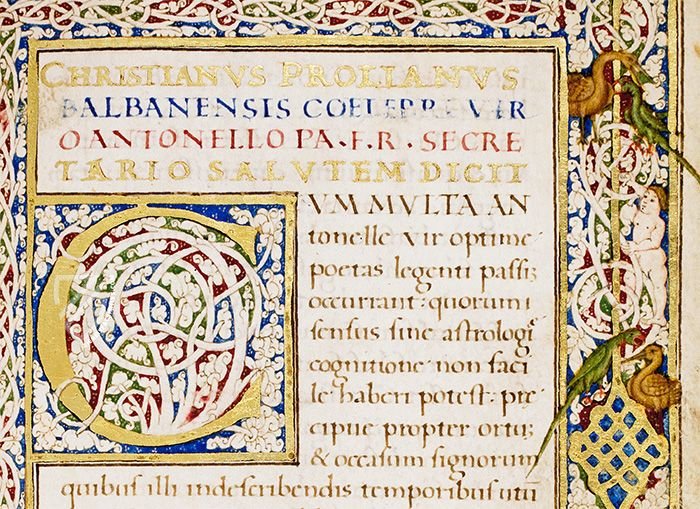
Christianus Prolianus Astronomia
The Sun and Four Closest Planets
This miniature is intended to show the comparative size of the Sun, Moon, Mars, Venus, Mercury, and Earth. The largest golden circle is obviously the sun, labelled SOLIS, while Mercury, Venus, and Mars are also golden, all with fine golden rays. Identifiable by the T shape that medieval mappa mundi often took, Earth has a pale color while the Moon is silver, which has tarnished and turned black over the centuries.
Set against a deep blue background, the miniature is framed by a wreath of green leaves. Even before Copernican heliocentrism, medieval astronomers already noted problems with Ptolemy’s system and their empirical observations that the sun does not seem to move, which may be suggested by the size and position of the sun here.
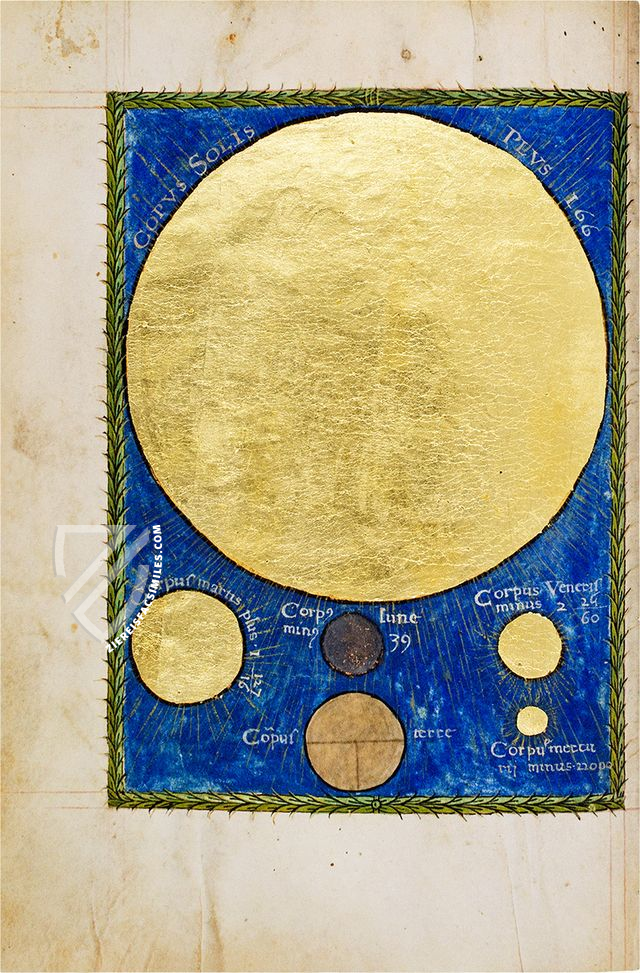
- Treatises / Secular Books
- Apocalypses / Beatus
- Astronomy / Astrology
- Bestiaries
- Bibles / Gospels
- Chronicles / History / Law
- Geography / Maps
- Saints' Lives
- Islam / Oriental
- Judaism / Hebrew
- Single Leaf Collections
- Leonardo da Vinci
- Literature / Poetry
- Liturgical Manuscripts
- Medicine / Botany / Alchemy
- Music
- Mythology / Prophecies
- Psalters
- Other Religious Books
- Games / Hunting
- Private Devotion Books
- Other Genres
- Afghanistan
- Armenia
- Austria
- Belgium
- Belize
- Bosnia and Herzegovina
- China
- Colombia
- Costa Rica
- Croatia
- Cyprus
- Czech Republic
- Denmark
- Egypt
- El Salvador
- Ethiopia
- France
- Germany
- Greece
- Guatemala
- Honduras
- Hungary
- India
- Iran
- Iraq
- Israel
- Italy
- Japan
- Jordan
- Kazakhstan
- Kyrgyzstan
- Lebanon
- Liechtenstein
- Luxembourg
- Mexico
- Morocco
- Netherlands
- Palestine
- Panama
- Peru
- Poland
- Portugal
- Romania
- Russia
- Serbia
- Spain
- Sri Lanka
- Sweden
- Switzerland
- Syria
- Tajikistan
- Turkey
- Turkmenistan
- Ukraine
- United Kingdom
- United States
- Uzbekistan
- Vatican City
- A. Oosthoek, van Holkema & Warendorf
- Aboca Museum
- Ajuntament de Valencia
- Akademie Verlag
- Akademische Druck- u. Verlagsanstalt (ADEVA)
- Aldo Ausilio Editore - Bottega d’Erasmo
- Alecto Historical Editions
- Alkuin Verlag
- Almqvist & Wiksell
- Amilcare Pizzi
- Andreas & Andreas Verlagsbuchhandlung
- Archa 90
- Archiv Verlag
- Archivi Edizioni
- Arnold Verlag
- ARS
- Ars Magna
- ArtCodex
- AyN Ediciones
- Azimuth Editions
- Badenia Verlag
- Bärenreiter-Verlag
- Belser Verlag
- Belser Verlag / WK Wertkontor
- Benziger Verlag
- Bernardinum Wydawnictwo
- BiblioGemma
- Biblioteca Apostolica Vaticana (Vaticanstadt, Vaticanstadt)
- Bibliotheca Palatina Faksimile Verlag
- Bibliotheca Rara
- Boydell & Brewer
- Bramante Edizioni
- Bredius Genootschap
- Brepols Publishers
- British Library
- C. Weckesser
- Caixa Catalunya
- Canesi
- CAPSA, Ars Scriptoria
- Caratzas Brothers, Publishers
- Carus Verlag
- Casamassima Libri
- Centrum Cartographie Verlag GmbH
- Chavane Verlag
- Christian Brandstätter Verlag
- Circulo Cientifico
- Club Bibliófilo Versol
- Club du Livre
- CM Editores
- Collegium Graphicum
- Collezione Apocrifa Da Vinci
- Comissão Nacional para as Comemorações dos Descobrimentos Portugueses
- Coron Verlag
- Corvina
- CTHS
- D. S. Brewer
- Damon
- De Agostini/UTET
- De Nederlandsche Boekhandel
- De Schutter
- Deuschle & Stemmle
- Deutscher Verlag für Kunstwissenschaft
- DIAMM
- Droz
- E. Schreiber Graphische Kunstanstalten
- Ediciones Boreal
- Ediciones Grial
- Ediclube
- Edições Inapa
- Edilan
- Editalia
- Edition Deuschle
- Edition Georg Popp
- Edition Leipzig
- Edition Libri Illustri
- Editiones Reales Sitios S. L.
- Éditions de l'Oiseau Lyre
- Editions Medicina Rara
- Editorial Casariego
- Editorial Mintzoa
- Editrice Antenore
- Editrice Velar
- Edizioni Edison
- Egeria, S.L.
- Eikon Editores
- Electa
- Emery Walker Limited
- Enciclopèdia Catalana
- Eos-Verlag
- Ephesus Publishing
- Ernst Battenberg
- Eugrammia Press
- Extraordinary Editions
- Fackelverlag
- Facsimila Art & Edition
- Facsimile Editions Ltd.
- Facsimilia Art & Edition Ebert KG
- Faksimile Verlag
- Feuermann Verlag
- Folger Shakespeare Library
- Franco Cosimo Panini Editore
- Friedrich Wittig Verlag
- Fundación Hullera Vasco-Leonesa
- G. Braziller
- Gabriele Mazzotta Editore
- Gebr. Mann Verlag
- Gesellschaft für graphische Industrie
- Getty Research Institute
- Giovanni Domenico de Rossi
- Giunti Editore
- Graffiti
- Grafica European Center of Fine Arts
- Guido Pressler
- Guillermo Blazquez
- Gustav Kiepenheuer
- H. N. Abrams
- Harrassowitz
- Harvard University Press
- Helikon
- Hendrickson Publishers
- Henning Oppermann
- Herder Verlag
- Hes & De Graaf Publishers
- Hoepli
- Holbein-Verlag
- Houghton Library
- Hugo Schmidt Verlag
- Idion Verlag
- Il Bulino, edizioni d'arte
- ILte
- Imago
- Insel Verlag
- Insel-Verlag Anton Kippenberger
- Instituto de Estudios Altoaragoneses
- Instituto Nacional de Antropología e Historia
- Introligatornia Budnik Jerzy
- Istituto dell'Enciclopedia Italiana - Treccani
- Istituto Ellenico di Studi Bizantini e Postbizantini
- Istituto Geografico De Agostini
- Istituto Poligrafico e Zecca dello Stato
- Italarte Art Establishments
- Jan Thorbecke Verlag
- Johnson Reprint Corporation
- Josef Stocker
- Josef Stocker-Schmid
- Jugoslavija
- Karl W. Hiersemann
- Kasper Straube
- Kaydeda Ediciones
- Kindler Verlag / Coron Verlag
- Kodansha International Ltd.
- Konrad Kölbl Verlag
- Kurt Wolff Verlag
- La Liberia dello Stato
- La Linea Editrice
- La Meta Editore
- Lambert Schneider
- Landeskreditbank Baden-Württemberg
- Leo S. Olschki
- Les Incunables
- Liber Artis
- Library of Congress
- Libreria Musicale Italiana
- Lichtdruck
- Lito Immagine Editore
- Lumen Artis
- Lund Humphries
- M. Moleiro Editor
- Maison des Sciences de l'homme et de la société de Poitiers
- Manuscriptum
- Martinus Nijhoff
- Maruzen-Yushodo Co. Ltd.
- MASA
- Massada Publishers
- McGraw-Hill
- Metropolitan Museum of Art
- Militos
- Millennium Liber
- Müller & Schindler
- Nahar - Stavit
- Nahar and Steimatzky
- National Library of Wales
- Neri Pozza
- Nova Charta
- Oceanum Verlag
- Odeon
- Orbis Mediaevalis
- Orbis Pictus
- Österreichische Staatsdruckerei
- Oxford University Press
- Pageant Books
- Parzellers Buchverlag
- Patrimonio Ediciones
- Pattloch Verlag
- PIAF
- Pieper Verlag
- Plon-Nourrit et cie
- Poligrafiche Bolis
- Presses Universitaires de Strasbourg
- Prestel Verlag
- Princeton University Press
- Prisma Verlag
- Priuli & Verlucca, editori
- Pro Sport Verlag
- Propyläen Verlag
- Pytheas Books
- Quaternio Verlag Luzern
- Reales Sitios
- Recht-Verlag
- Reichert Verlag
- Reichsdruckerei
- Reprint Verlag
- Riehn & Reusch
- Roberto Vattori Editore
- Rosenkilde and Bagger
- Roxburghe Club
- Salerno Editrice
- Saltellus Press
- Sandoz
- Sarajevo Svjetlost
- Schöck ArtPrint Kft.
- Schulsinger Brothers
- Scolar Press
- Scrinium
- Scripta Maneant
- Scriptorium
- Shazar
- Siloé, arte y bibliofilia
- SISMEL - Edizioni del Galluzzo
- Sociedad Mexicana de Antropología
- Société des Bibliophiles & Iconophiles de Belgique
- Soncin Publishing
- Sorli Ediciones
- Stainer and Bell
- Studer
- Styria Verlag
- Sumptibus Pragopress
- Szegedi Tudomànyegyetem
- Taberna Libraria
- Tarshish Books
- Taschen
- Tempus Libri
- Testimonio Compañía Editorial
- Thames and Hudson
- The Clear Vue Publishing Partnership Limited
- The Facsimile Codex
- The Folio Society
- The Marquess of Normanby
- The Richard III and Yorkist History Trust
- Tip.Le.Co
- TouchArt
- TREC Publishing House
- TRI Publishing Co.
- Trident Editore
- Tuliba Collection
- Typis Regiae Officinae Polygraphicae
- Union Verlag Berlin
- Universidad de Granada
- University of California Press
- University of Chicago Press
- Urs Graf
- Vallecchi
- Van Wijnen
- VCH, Acta Humaniora
- VDI Verlag
- VEB Deutscher Verlag für Musik
- Verlag Anton Pustet / Andreas Verlag
- Verlag Bibliophile Drucke Josef Stocker
- Verlag der Münchner Drucke
- Verlag für Regionalgeschichte
- Verlag Styria
- Vicent Garcia Editores
- W. Turnowski Ltd.
- W. Turnowsky
- Waanders Printers
- Wiener Mechitharisten-Congregation (Wien, Österreich)
- Wissenschaftliche Buchgesellschaft
- Wissenschaftliche Verlagsgesellschaft
- Wydawnictwo Dolnoslaskie
- Xuntanza Editorial
- Zakład Narodowy
- Zollikofer AG

